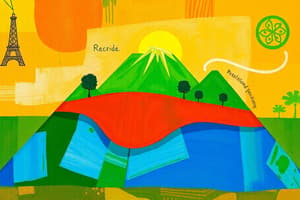Podcast
Questions and Answers
What is zionism?
What is zionism?
What does the term 'push factors' refer to?
What does the term 'push factors' refer to?
What is a primary characteristic of an absolute monarchy?
What is a primary characteristic of an absolute monarchy?
Which statistic is most commonly used to determine a nation’s standard of living?
Which statistic is most commonly used to determine a nation’s standard of living?
Signup and view all the answers
What is a main characteristic of a functional region?
What is a main characteristic of a functional region?
Signup and view all the answers
Which stages of population pyramids are likely to indicate a growing population?
Which stages of population pyramids are likely to indicate a growing population?
Signup and view all the answers
What are longitude lines also called?
What are longitude lines also called?
Signup and view all the answers
Which of the following is an example of a non-renewable resource?
Which of the following is an example of a non-renewable resource?
Signup and view all the answers
Which of the following best defines cultural diffusion?
Which of the following best defines cultural diffusion?
Signup and view all the answers
What is the common word associated with a free market economy?
What is the common word associated with a free market economy?
Signup and view all the answers
Which economic sector typically involves the extraction of raw materials?
Which economic sector typically involves the extraction of raw materials?
Signup and view all the answers
What is an example of an inexhaustible resource?
What is an example of an inexhaustible resource?
Signup and view all the answers
What can be inferred from analyzing a population pyramid?
What can be inferred from analyzing a population pyramid?
Signup and view all the answers
Study Notes
Renewable Resources
- Resources that are replenished naturally and can be used repeatedly
- Examples: sunlight, wind, water, trees
Non-renewable Resources
- Resources that are not replenished naturally or are replenished very slowly
- Examples: fossil fuels (coal, oil, natural gas), minerals, and some types of metals
Inexhaustible Resources
- Resources that are continuously available and are not depleted by use.
- Examples: sunlight, wind, geothermal energy
Population Pyramids
- Visual representations of the age and sex distribution of a population.
- Useful to identify stage of development, level of development and challenges, dependency ratio.
Stages of Population Pyramids and Population Growth
- Growing population pyramids will typically have a larger proportion of younger individuals (a wide base).
- Declining population pyramids will typically have a smaller proportion of younger individuals (a narrow base).
Elements of Population Pyramids
- Age groups are presented on the vertical axis of the population pyramid.
- The horizontal axis represents population numbers.
Inferences from Population Pyramids
- Stage of development: (e.g., pre-industrial, transitional, industrial, post-industrial)
- Level of development: (e.g., Less Developed Country (LDC), Newly Industrialized Country (NIC), More Developed Country (MDC))
- Dependency ratio: The ratio of dependents (young population and elderly) to the working-age population.
- Possible Challenges: Understanding the age and sex distribution can identify challenges of countries which have larger percentages of dependent residents.
Cultural Hearth
- A center of innovation and invention, the source of cultural ideas and practices for a region.
Cultural Diffusion
- The spread of cultural traits, ideas, and beliefs from one culture to another.
- Examples: religions, music, clothing styles, technologies
Latitude and Longitude Lines
- Latitude: Imaginary east-west lines parallel to the equator. Measured in degrees north and south.
- Longitude: Imaginary north-south lines that run through the poles. Measured in degrees east and west.
Types of Maps
- Political maps: show political boundaries of countries, states, cities
- Physical maps: show elevation, mountains, rivers, oceans
- Thematic maps: show specific information such as population density, rainfall, or temperature.
Cartograms
- Maps where the sizes of the regions are proportional to a specific data value.
Physical Features Influencing Population Density
- Water: Rivers, lakes, oceans provide water resources and transportation routes.
- Fertile land: Areas with fertile soil offer good conditions for agriculture and support higher populations.
- Climate: Favorable temperature and rainfall conditions for agriculture and human habitation.
GPS
- Global Positioning System: A network of satellites that allows precise location determination of places and objects on Earth.
Rural vs. Urban Life
- Rural areas: characterise a slower paced lifestyle, often focused on agriculture or locally produced goods.
- Urban areas: are associated with a faster paced lifestyle, and greater diversity in jobs and services.
Polytheistic Religion
- A religion with more than one god.
Monotheistic Religion
- A religion with one god.
Animistic Religion
- The belief that natural objects, places, and phenomena have spirits.
Enculturation
- The process by which individuals learn and adopt the ways of life, values, beliefs and customs of a culture.
Religion Distribution
- Information on world religions and branches are presented which may include origin, holy texts, founders, and other identifying characteristics.
Latitude and Climate
- Latitude influences climate because the angle at which sunlight strikes the Earth varies with latitude. Higher latitude results in indirect sunlight and lower temperatures.
Globalization
- The increasing interconnectedness and interdependence of countries through trade, technology, culture, and communication.
Subsistence Farming
- Farming where the products from farming are primarily consumed by the farmers.
Commercial Farming
- Farming where the products are intended to be sold in the marketplace.
Free Market Economy
- An economy in which prices are determined by supply and demand. This type of economy is usually associated with democratic governments.
Mixed Economy
- An economy with elements of both free-market and government control.
Command Economy
- An economy in which the government has a controlling influence over prices and production. This system is frequently associated with communist or authoritarian governments.
Economic Sectors
- Primary: Raw materials and resources extraction (farming, mining)
- Secondary: Manufacturing and processing (factories, construction)
- Tertiary: Services sector (retail, healthcare, education)
- Quaternary: Information and technology sector (research, education)
- Quinary: Highest-level decision-making (government, CEOs, top management)
History of Israel/Palestine
- A summary of the historical context of the conflict and the geographical locations.
Zionism
- A political movement for the establishment and development of a Jewish national homeland in Palestine.
Standard of Living
- The degree of wealth, comfort, and material goods accessible to a particular person or population.
LDC, NIC, and MDC
- Classifications based on factors such as economic output.
Total Fertility Rate (TFR)
- The average number of children that would be born to a woman over her lifetime if she were to pass through her childbearing years conforming to current age-specific fertility rates. A TFR is useful for estimating long-term population growth.
Immigrant
- A person who comes to live permanently in a foreign country.
Emigrant
- A person who leaves their country to live permanently in another country
Refugee
- A person who is forced to leave their country due to danger or persecution.
Internally Displaced Persons (IDPs)
- People displaced from their homes but within the borders of their own country
Push Factors
- Reasons why people leave a particular region or country to live elsewhere; e.g., war, poverty, persecution, famine
Pull Factors
- Reasons that draw people to a specific region or country, e.g., increased economic opportunities, safety, family reunification.
Asylum Seekers
- People who are seeking international protection (asylum) but have not yet had their claim processed.
Formal Regions
- Regions that are demarcated by official boundaries; e.g., states, countries, or administrative divisions.
Functional Regions
- Regions that are defined by a central point or node, and the connections and interactions between the central point and surrounding areas; e.g., a city and its metropolitan area.
Perceptual Regions
- Regions that are defined by subjective perceptions and beliefs shared by a group of people; often cultural or historical in nature, e.g., the "American South" or the "Midwest."
Absolute and Relative Locations
- Absolute location: Precise position of something using coordinates (latitude and longitude).
- Relative location: The position of something in relation to other things (e.g., "next to the river," "south of the city").
Human Environment Interaction
- Modification, adaptation and dependency of humans on the environment. Modification = Changing the natural environment; adaptation = adjusting to existing conditions and dependency = relying on natural resources
Supranational Organization
- Organizations that transcend national borders, e.g., the United Nations, the European Union.
Fertility Rates and Country Development
- Relationship between fertility rates (TFR) and levels of a country's development. Low TFR often indicates more advanced economies.
State
- Politically organized territory administered by a sovereign government.
Nation-State
- A state whose population is largely composed of a single national group.
Stateless Nation
- Ethnic or cultural community or group that does not have its own state.
Commodity Dependency
- Over-reliance on a specific commodity for economic well being.
Brain Drain
- The emigration of highly skilled or educated individuals from a specific region or country.
Standard of Living and Quality of Life
- Standard of living: Material factors like income, access to goods.
- Quality of life: Non-material factors like health, education, environment and social conditions.
Human Development Index (HDI)
- A composite statistic of life expectancy, education, and per capita income indicators, to rank countries into four tiers of development.
Cold War
- A period of geopolitical tension between the Soviet Union and the United States and their respective allies.
Studying That Suits You
Use AI to generate personalized quizzes and flashcards to suit your learning preferences.
Related Documents
Description
This quiz covers key concepts in environmental science, focusing on renewable, non-renewable, and inexhaustible resources. Additionally, it explores population pyramids, population growth stages, and the significance of age and sex distribution. Test your understanding of these essential topics!




